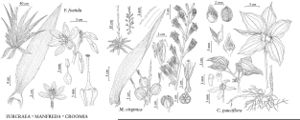Furcraea
Bull. Sci. Soc. Philom. Paris 1: 65. 1793.
| Taxon | Illustrator ⠉ | |
|---|---|---|
 | Furcraea foetida Manfreda virginica Croomia pauciflora | Bee F. Gunn Bee F. Gunn Bee F. Gunn |
Plants massive multiannuals, scapose; trunks usually absent, to 6 m when present. Stems aboveground. Leaves up to 50, broad or narrowly lanceolate, to 3.3 m, rigid or flexible, very fibrous, margins with small or large corneous teeth, mature apex a firm, blunt point. Inflorescences paniculate, to 13 m, frequently producing bulblets. Flowers in clusters of 2–5, drooping; tepals spreading, distinct except at base, greenish or white, ovate to oblong, longer than stamens and styles; filaments abruptly expanded below middle; ovary inferior; style dilated and 3-lobed proximal to middle; stigma 3-lobed. Fruits capsular, globose to cylindrical, to 8 cm, infrequently produced. Seeds many, black, flat, 2 rows per locule. x = 30.
Distribution
Introduced; Mexico, Central America, West Indies, South America
Discussion
Species ca. 22 (2 in the flora).
A number of Furcraea species are cultivated in warm climates worldwide as ornamentals and for cordage from leaf fibers. Reproduction by bulblets from the inflorescence is common.
Furcraea was divided by J. R. Drummond (1907) into three variable groups based on leaf margins. Plants of two of these groups are reported to persist or reproduce locally in southern Florida. Specimens are scarce. Within Furcraea there is a large synonymy, including names that are difficult to apply with certainty because they are based on incomplete specimens or European cultivated material.
R. W. Long and O. Lakela (1971) mentioned Furcraea macrophylla Baker as an ornamental that possibly persists in old sites, but I have seen no herbarium specimens that document its presence in Florida. That species is marked by larger leaves with larger, horny, hooked teeth.
Selected References
None.
Lower Taxa
Key
| 1 | Leaves smooth or striate, margins usually entire at least in distal half. | Furcraea foetida |
| 1 | Leaves roughened by small points, margins with hard, curved teeth. | Furcraea selloa |
"thick" is not a number. "thin" is not a number."broad" is not a number.